Unzipping the SQL Developer kit causes a folder named sqldeveloper to be created under the folder (for example, C:Program Filessqldeveloper). It also causes many files and folders to be placed in and under that directory. To start SQL Developer, go to sqldeveloper, and double-click sqldeveloper.exe. Sql developer free download - SQL Anywhere Developer Edition, Insight Developer for Oracle, Iridient Developer, and many more programs. Sql free download - OpenBase SQL, SQL Anywhere Developer Edition, SQL Anywhere Studio, and many more programs.
This video contains a total demonstration of how to connect to oracle 12c release 1 on Oracle linux server 6.4 64 bit from MAC OSX Mountain Lion 7.0 using SQ.
I previously explained how to install SQL Server on a Mac via a Docker container. When I wrote that, SQL Server 2017 was the latest version of SQL Server, and it had just been made available for Linux and Docker (which means that you can also install it on MacOS systems).
In late 2018, Microsoft announced SQL Server 2019 Preview, and subsequently announced general release in late 2019. The installation process for SQL Server 2019 is exactly the same as for SQL Server 2017. The only difference is that you need to use the container image for SQL Server 2019 instead of the 2017 image. Here I show you how to do that.
Also, if you already have SQL Server 2017 installed, and you want to install SQL Server 2019 without removing the 2017 version, you’ll need to allocate a different port number on your host. I show you how to do that too.
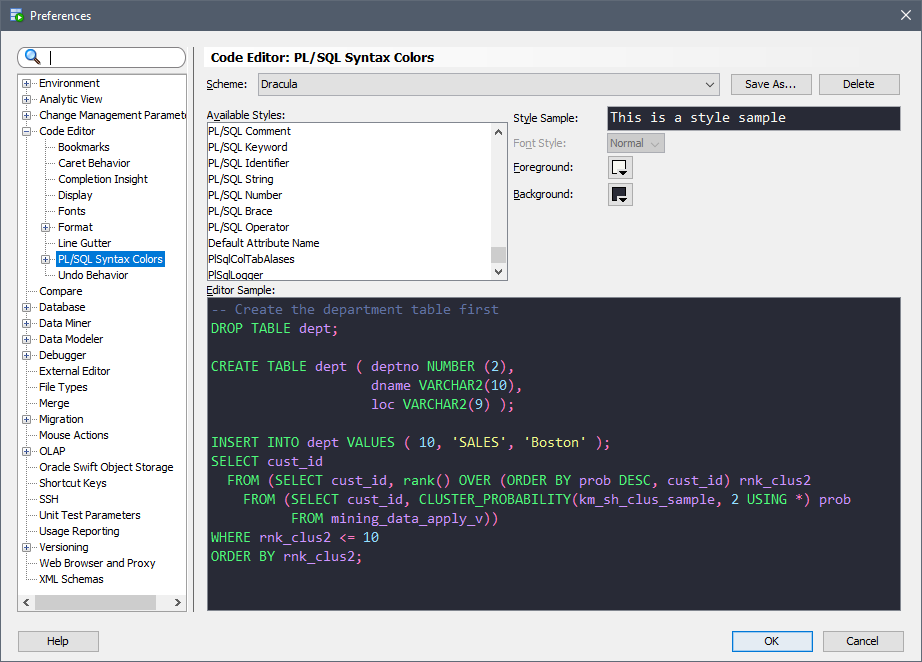
Docker
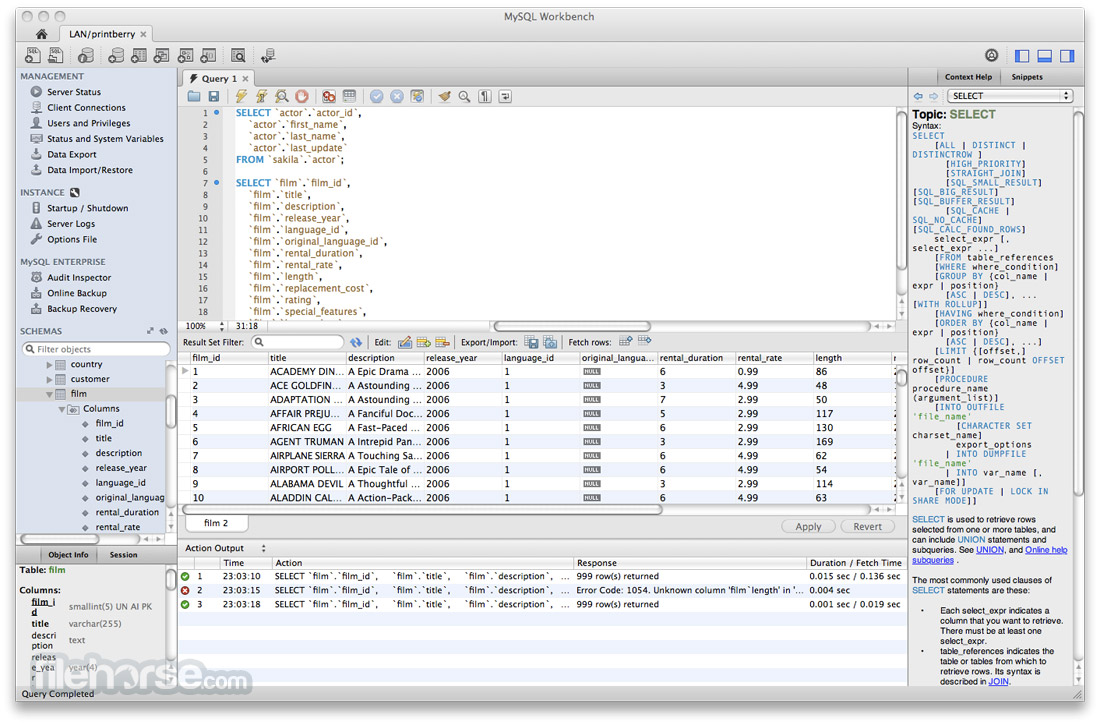
The first step is to install Docker. If you already have Docker installed you can skip this step (and jump straight to SQL Server).
Docker is a platform that enables software to run in its own isolated environment. Therefore, SQL Server 2019 can be run on Docker in its own isolated container.
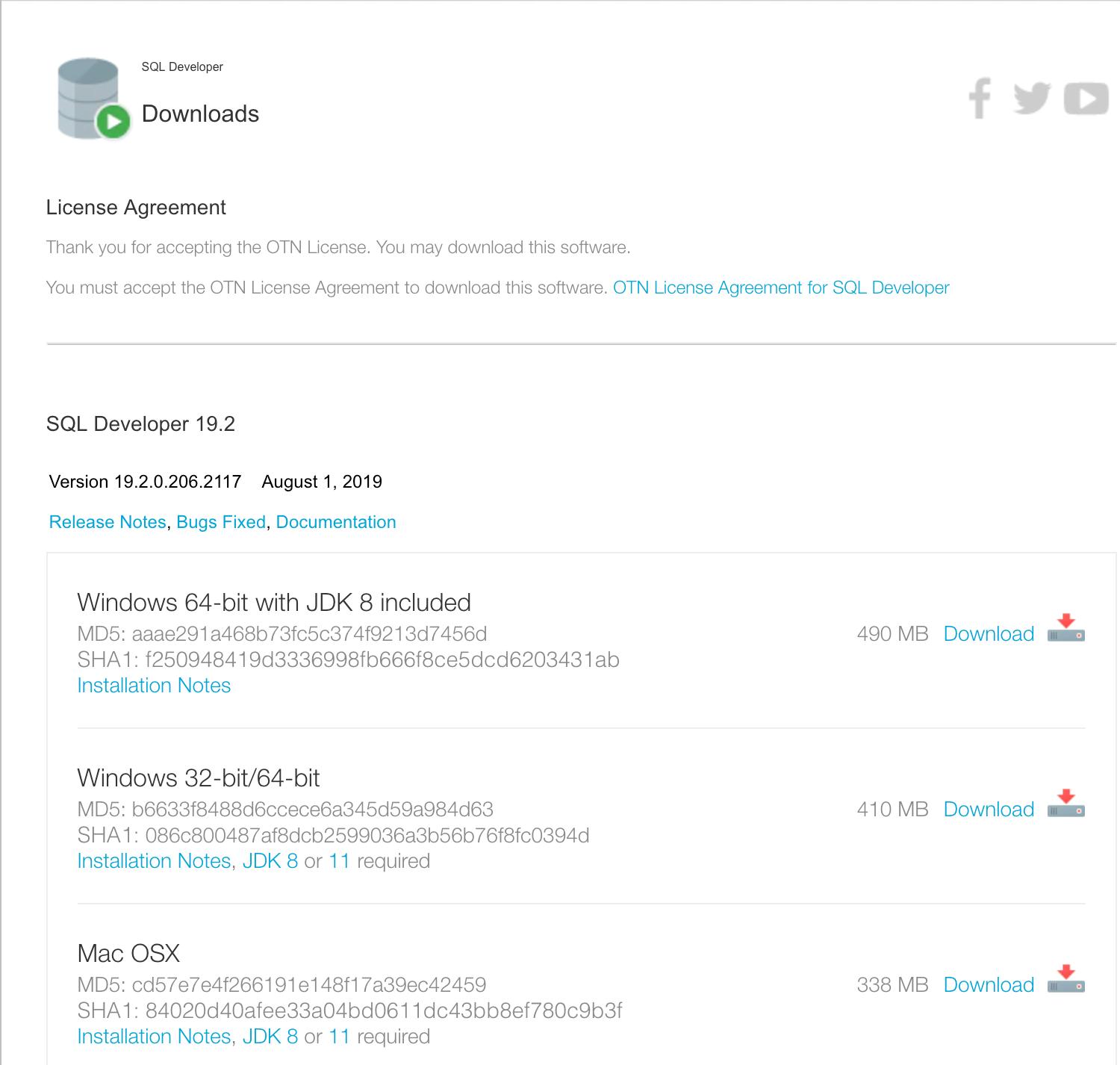
Install Docker
To download, visit the Docker CE for Mac download page and click Get Docker.
To install, double-click on the .dmg file and then drag the Docker.app icon to your Application folder.
Launch Docker
Launch Docker the same way you’d launch any other application (eg, via the Applications folder, the Launchpad, etc).
When you open Docker, you might be prompted for your password so that Docker can install its networking components and links to the Docker apps. Go ahead and provide your password, as Docker needs this to run.
Increase the Memory
By default, Docker will have 2GB of memory allocated to it. I’d suggest increasing it to 4GB if you can.
To do this:
- Select Preferences from the little Docker icon in the top menu
- Slide the memory slider up to at least 4GB
- Click Apply & Restart
SQL Server
Now that Docker has been installed and configured, we can download and install SQL Server 2019.
Download SQL Server 2019
Open a Terminal window and run the following command.
This downloads the latest SQL Server for Linux Docker image to your computer.
You can also check for the various container image options on the Docker website if you wish.
Note that, at the time I wrote this article, I used the following image:
Therefore, all examples below reflect that version.
Launch the Docker Image
Run the following command to launch an instance of the Docker image you just downloaded:
Just change
Bartto a name of your choosing, andreallyStrongPwd#123to a password of your choosing.If you get a “port already allocated” error, see below.
Here’s an explanation of the parameters:
-e 'ACCEPT_EULA=Y'- The
Yshows that you agree with the EULA (End User Licence Agreement). This is required. -e 'SA_PASSWORD=reallyStrongPwd#123'- Required parameter that sets the
sadatabase password. -p 1433:1433- This maps the local port 1433 to port 1433 on the container. The first value is the TCP port on the host environment. The second value is the TCP port in the container.
--name Bart- Another optional parameter. This parameter allows you to name the container. This can be handy when stopping and starting your container from the Terminal. You might prefer to give it a more descriptive name like
sql_server_2019or similar. -d- This optional parameter launches the Docker container in daemon mode. This means that it runs in the background and doesn’t need its own Terminal window open. You can omit this parameter to have the container run in its own Terminal window.
mcr.microsoft.com/mssql/server:2019-CTP3.2-ubuntu- This tells Docker which image to use.
Password Strength
You need to use a strong password. Microsoft says this about the password:
The password should follow the SQL Server default password policy, otherwise the container can not setup SQL server and will stop working. By default, the password must be at least 8 characters long and contain characters from three of the following four sets: Uppercase letters, Lowercase letters, Base 10 digits, and Symbols.
Error – “Port already allocated”?
If you get an error that says something about “port is already allocated”, then perhaps you already have SQL Server installed on another container that uses that port. In this case, you’ll need to map to a different port on the host.
Therefore, you could change the above command to something like this:
In this case I simply changed
-p 1433:1433to-p 1400:1433. Everything else remains the same.You may now get an error saying that you need to remove the existing container first. To do that, run the following (but swap
Bartwith the name of your own container):Once removed, you can try running the previous command again.
Note that if you change the port like I’ve done here, you will probably need to include the port number when connecting to SQL Server from any database tools from your desktop. For example, when connecting via the Azure Data Studio (mentioned below), you can connect by using
Localhost,1400instead of justLocalhost. Same with mssql-cli, which is a command line SQL tool.
Check Everything
Now that we’ve done that, we should be good to go. Let’s go through and run a few checks.
Check the Docker container (optional)
You can type the following command to check that the Docker container is running.
In my case I get this:
This tells me that I have two docker containers up and running: one called Bart and the other called Homer.
Connect to SQL Server
Here we use the SQL Server command line tool called “sqlcmd” inside the container to connect to SQL Server.
Enter your password if prompted.
Now that you’re inside the container, connect locally with sqlcmd:
This should bring you to the sqlcmd prompt 1>.
Run a Quick Test
Run a quick test to check that SQL Server is up and running. For example, check the SQL Server version by entering this:
This will bring you to a command prompt 2> on the next line. To execute the query, enter:
Result:
If you see a message like this, congratulations — SQL Server is now up and running on your Mac!
If you prefer to use a GUI to manage SQL Server, read on.
Azure Data Studio
Azure Data Studio is a free GUI management tool that you can use to manage SQL Server on your Mac. You can use it to create and manage databases, write queries, backup and restore databases, and more.
Azure Data Studio is available on Windows, Mac and Linux.
Here are some articles/tutorials I’ve written for Azure Data Studio:
Another Free SQL Server GUI – DBeaver
Another SQL Server GUI tool that you can use on your Mac (and Windows/Linux/Solaris) is DBeaver.
DBeaver is a free, open source database management tool that can be used on most database management systems (such as MySQL, PostgreSQL, MariaDB, SQLite, Oracle, DB2, SQL Server, Sybase, Microsoft Access, Teradata, Firebird, Derby, and more).
I wrote a little introduction to DBeaver, or you can go straight to the DBeaver download page and try it out with your new SQL Server installation.
Note:
This guide assumes that you plan to download the SQL Developer kit (.zip) file and install it as a freestanding tool.If you plan to use SQL Developer as part of the Oracle Database release 11 installation, see the Oracle Database installation documentation.
Please read the information in this chapter before you install Oracle SQL Developer. This chapter contains the following major sections:
1.1 SQL Developer System Recommendations
This section describes the recommended minimum values for CPU, memory, display, disk storage, and other resources on the supported systems.
Table 1-1 Recommendations for Windows Systems
| Resource | Recommended Minimum Value |
|---|---|
Operating System | Windows 2000-Service Pack 4 Windows XP-Service Pack 2 Windows 2003 R2 |
CPU Type and Speed | Pentium IV 2 GHz MHz or faster |
Memory | 1 GB RAM |
Display | 65536 colors, set to at least 1024 X 768 resolution |
Hard Drive Space | 42 MB if you already have JDK 1.5 110 MB if you do not have JDK 1.5 |
Java SDK | JDK 5.0 Update 6 or later for Windows, available at: |
Table 1-2 Recommendations for Linux Systems
| Resource | Recommended Minimum Value |
|---|---|
Operating System | Red Hat Enterprise Linux 3.0 Fedora Core 4 |
CPU Type and Speed | Pentium IV 2 GHz or faster |
Memory | 1 GB RAM |
Display | 65536 colors, set to at least 1024 X 768 resolution |
Hard Drive Space | 110 MB |
Java SDK | JDK 5.0 Update 6 or later for Linux, available at: |
Table 1-3 Recommendations for Mac OS X Systems
| Resource | Recommended Minimum Value |
|---|---|
Operating System | Apple Mac OS X Version 10.4.x |
CPU Type and Speed | Dual 1.25 GHz G4/G5 (1 GHz G4 minimum) |
Memory | 1.5 GB RAM (1 GB minimum) |
Display | 'Thousands' of colors |
Hard Drive Space | 110 MB |
Java SDK | Sun J2SE 1.5 release 1, available at: |
1.2 Installing and Starting SQL Developer
This section contains subsections with instructions for installing SQL Developer on all supported systems.
SQL Developer does not require an installer. To install SQL Developer, you will need an unzip tool. You can download a free, cross-platform unzip tool, Info-Zip, available at http://www.info-zip.org/.
Important:
Do not install SQL Developer into any existingORACLE_HOME. You will not be able to uninstall it using Oracle Universal Installer.Important:
If you are using a pre-release (Early Adopter) version of SQL Developer, and if you want to be able to continue to use this pre-release version after installing the official release kit, you must unzip the official release kit into a different directory than the one used for the pre-release version.If Oracle Database (Release 11 or later) is also installed, a version of SQL Developer is also included and is accessible through the menu system under Oracle. This version of SQL Developer is separate from any SQL Developer kit that you download and unzip on your own, so do not confuse the two, and do not unzip a kit over the SQL Developer files that are included with Oracle Database. Suggestion: Create a shortcut for the SQL Developer executable file that you install, and always use it to start SQL Developer.
For Windows systems, there are two kits: one for systems on which the Sun Java SDK release 1.5.0_06 or later is installed, and another for systems with no Java SDK or a Sun Java SDK release earlier than 1.5.0_06. Be sure to download the appropriate kit.
Before you install SQL Developer, look at the remaining sections of this guide to see if you need to know or do anything else first.
The steps for installing SQL Developer depend on whether or not you will be using it on a Windows system that does not have the Sun Java SDK release 1.5.0_06 or later installed:
For a Windows system with the Sun Java release 1.5.0_06 or later installed, follow the instructions in Section 1.2.1.
For all other systems (Linux and Mac OS X systems, and Windows systems with no Java SDK or a Sun Java SDK release earlier than 1.5.0_06 or later installed), follow the instructions in Section 1.2.2.
1.2.1 Windows Systems with JDK5.0
To install and start SQL Developer on a Windows system on which the Sun Java J2SE JDK 5.0 (Update 6 or later) is installed, follow these steps:
Unzip the SQL Developer kit into a folder (directory) of your choice (for example,
C:Program Files). This folder will be referred to as<sqldeveloper_install>.Unzipping the SQL Developer kit causes a folder named
sqldeveloperto be created under the<sqldeveloper_install>folder (for example,C:Program Filessqldeveloper). It also causes many files and folders to be placed in and under that directory.To start SQL Developer, go to <sqldeveloper_install>
sqldeveloper, and double-clicksqldeveloper.exe.
If you are asked to enter the full pathname for java.exe, click Browse and find java.exe. For example, the path might have a name similar to C:Program FilesJavajdk1.5.0_06binjava.exe.
After SQL Developer starts, you can connect to any database by right-clicking the Connections node in the Connections Navigator and selecting New Connection. Alternatively, if you have any exported connections (see Section 1.4 or Section 1.10), you can import these connections and use them.
You can learn about SQL Developer by clicking Help, then Table of Contents, and reading the help topics under SQL Developer Concepts and Usage.
1.2.2 Linux and Mac OS X Systems, and Windows Systems without JDK 5.0
SQL Developer requires that the Sun Java J2SE JDK 5.0 (Update 6 or later) be installed on the system. If you need to install this JDK, go to http://java.sun.com/j2se/1.5.0/download.jsp and click the link for downloading JDK 5.0 Update 12 (or the most recent available update).
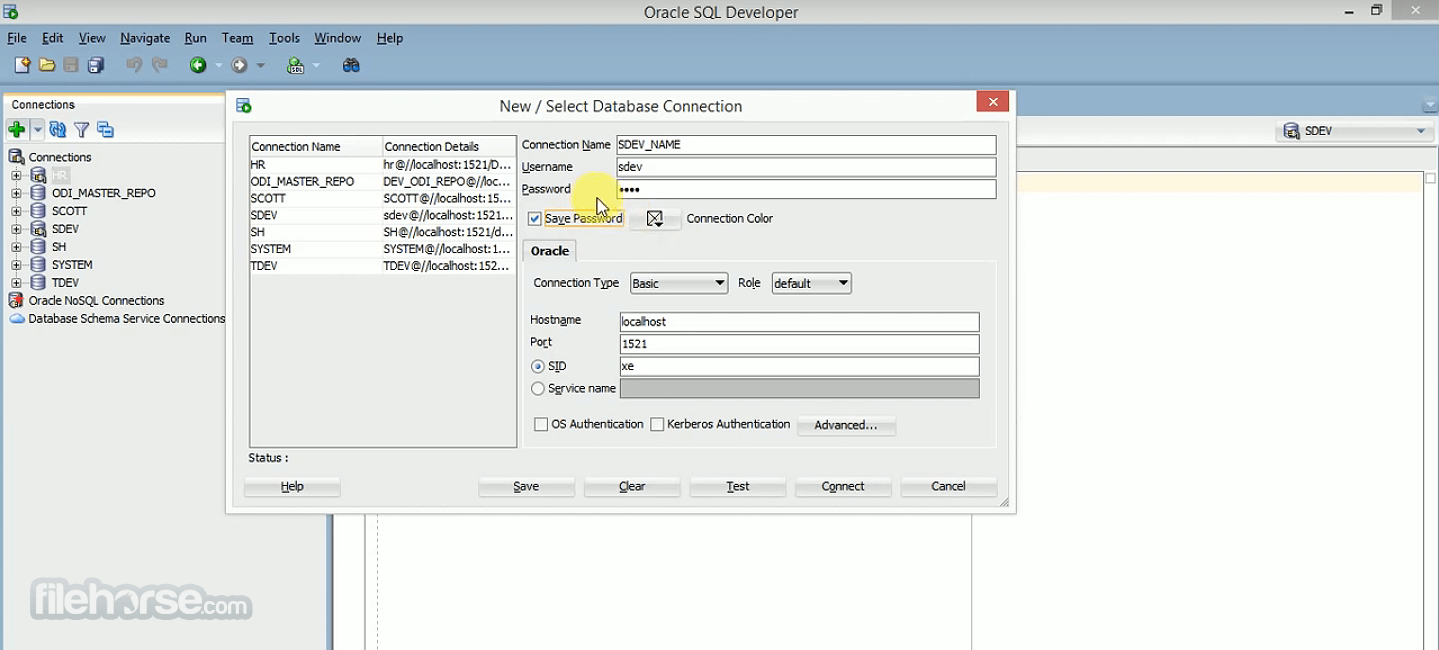
To install and start SQL Developer, follow these steps:
Unzip the SQL Developer kit into a directory (folder) of your choice. This directory location will be referred to as
<sqldeveloper_install>.Unzipping the SQL Developer kit causes a directory named
sqldeveloperto be created under the<sqldeveloper_install>directory. It also causes many files and folders to be placed in and under that directory.To start SQL Developer, go to the
sqldeveloperdirectory under the<sqldeveloper_install>directory, and do one of the following, as appropriate for your operating system:On Linux and Mac OS X systems, run sh sqldeveloper.sh.
On Windows systems, double-click
sqldeveloper.exe.
After SQL Developer starts, you can connect to any database by right-clicking the Connections node in the Connections Navigator and selecting New Connection. Alternatively, if you have any exported connections (see Section 1.4 or Section 1.10), you can import these connections and use them.
You can learn about SQL Developer by clicking Help, then Table of Contents, and reading the help topics under SQL Developer Concepts and Usage.
1.3 Migrating User Settings from a Previous Release
The first time you start SQL Developer after installing it or after adding any extensions, you are asked if you want to migrate your user settings from a previous release. (This occurs regardless of whether there was a previous release on your system.)
Note:
Migration of user settings is supported only from SQL Developer Release 1.1.3 or later to Release 1.5.These settings refer to database connections, reports, and certain SQL Developer user preferences that you set in a previous version by clicking Tools and then Preferences. However, some user preferences are not saved, and you must re-specify these using the new release.
To migrate user settings from a previous SQL Developer release:
Unzip the Release 1.5 kit into an empty directory (folder). Do not delete or overwrite the directory into which you unzipped the kit for the previous SQL Developer release.
When you start SQL Developer Release 1.5, click Yes when asked if you want to migrate settings from a previous release.
In the dialog box that is displayed, do not accept the default location for the settings. Instead, specify the location of your settings for the previous release, which might be a folder whose path ends with
sqldevelopersqldevelopersystemorDocuments and Settings<user>Application DataSQL Developersystem.
See also Section 1.4, 'Migrating Information from Previous Releases'.
1.4 Migrating Information from Previous Releases
If you have used a previous release of SQL Developer, you may want to preserve database connections that you have been using. To preserve database connections, save your existing database connections in an XML file. To save the connections, right-click the Connections node in the Connections Navigator and select Export Connections. After you complete the installation described in this guide, you can use those connections by right-clicking the Connections node in the Connections Navigator and selecting Import Connections
If you want to use any user-defined reports or the SQL history from a previous version, see Section 1.5 for information about where these are located. If you have user-defined reports and SQL history from Release 1.0, they are modified by any later SQL Developer release to a format that is different from and incompatible with Release 1.0.
SQL Developer preferences (specified by clicking Tools and then Preferences) from a pre-release version of the current release cannot currently be saved and reused; you must re-specify any desired preferences.
Note:
If you want to uninstall your pre-release version of SQL Developer before installing this release, see Section 1.10, 'Uninstalling SQL Developer'.1.5 Location of User-Related Information
SQL Developer stores user-related information in several places, with the specific location depending on the operating system and certain environment specifications. User-related information includes user-defined reports, user-defined snippets, SQL Worksheet history, code templates, and SQL Developer user preferences. In most cases, your user-related information is stored outside the SQL Developer installation directory hierarchy, so that it is preserved if you delete that directory and install a new version.
The user-related information is stored in or under the following location:
On Windows systems: the
HOMEenvironment variable location, if defined; otherwise theSQLDEVELOPER_USER_DIRlocation, if defined; otherwise as indicated in the following tableOn Linux and Mac OS X systems: the
SQLDEVELOPER_USER_DIRlocation, if defined; otherwise as indicated in the following table
Sql Developer Tool Download For Mac
The following table shows the typical default locations (under a directory or in a file) for specific types of resources on different operating systems. (Note the period in the name of any directory named .sqldeveloper.)
Table 1-4 Default Locations for User-Related Information
| Resource Type | System (Windows, Linux, or Mac OS X) |
|---|---|
User-defined reports | Windows: C:Documents and Settings<user-name>Application DataSQL DeveloperUserReports.xml Linux or Mac OS X: ~/.sqldeveloper/UserReports.xml |
User-defined snippets | Windows: C:Documents and Settings<user-name>Application DataSQL DeveloperUserSnippets.xml Linux: ~/.sqldeveloper/ UserSnippets.xml Mac OS X: /Users/<Your user>/Library/Application Support/ SQLDeveloper/UserSnippets.xml |
SQL history | Windows: C:Documents and Settings<user-name>Application DataSQL DeveloperSqlHistory.xml Linux: ~/.sqldeveloper/ SqlHistory.xml Mac OS X: /Users/<Your user>/Library/Application Support/ SQLDeveloper/ SqlHistory.xml |
Code templates | Windows: C:Documents and Settings<user-name>Application DataSQL Developer CodeTemplate.xml Linux: ~/.sqldeveloper/ CodeTemplate.xml Mac OS X: /Users/<Your user>/Library/Application Support/ SQLDeveloper/ CodeTemplate.xml |
SQL Developer user preferences | Windows: C:Documents and Settings<user-name>Application DataSQL Developersystemn.n.n.n.n Linux or Mac OS X: ~/.sqldeveloper/systemn.n.n.n.n |
To specify a nondefault SQLDEVELOPER_USER_DIR location, do either of the following:
Set the
SQLDEVELOPER_USER_DIRenvironment variable to specify another directory path.Edit the
<sqldeveloper_install>sqldevelopersqldeveloperbinsqldeveloper.conffile and substitute the desired directory path forSQLDEVELOPER_USER_DIRin the following line:
If you want to prevent other users from accessing your user-specific SQL Developer information, you must ensure that the appropriate permissions are set on the directory where that information is stored or on a directory above it in the path hierarchy. For example, on a Windows system you may want to ensure that the SQL Developer folder and the <user-name>Application DataSQL Developer folder under Documents and Settings are not shareable; and on a Linux or Mac OS X system you may want to ensure that the ~/.sqldeveloper directory is not world-readable.
1.6 Database Certification for SQL Developer (Oracle and Third-Party)
This section describes Oracle and non-Oracle (third-party) databases that are certified for use with SQL Developer.
Table 1-5 lists the Oracle database certifications.
Table 1-5 Oracle Database Certification for SQL Developer
| Product | Releases |
|---|---|
Oracle Database | Oracle9i (9.2.0.1 and later) Oracle10g Oracle11g |
Oracle Database Express Edition | Oracle10g |
SQL Developer can be used to view metadata and data of several non-Oracle (third-party) databases. Table 1-6 lists the third-party database certifications.
Table 1-6 Non-Oracle (Third-Party) Database Certification for SQL Developer
| Database | Releases | Notes |
|---|---|---|
Microsoft Access | Access 97 Access 2000 Access XP (2002) Access 2003 | For any Access release: no JDBC driver needed, but you must ensure read access to system tables in the .mdb file. |
Microsoft SQL Server | SQL Server 7 SQL Server 2000 SQL Server 2005 | For any Microsoft SQL Server release: JDBC driver jtds-1.2.jar required; included in jtds-1.2-dist.zip available from sourceforge.net; also available through Help, Check for Updates. |
MySQL | MySQL 3.x MySQL 4.x MySQL 5.x | For any MySQL release: JDBC driver required. For MySQL 5.x: mysql-connector-java-5.0.4-bin.jar, which is included in mysql-connector-java-5.0.4.zip; also available through Help, Check for Updates. (Do not use the latest MySQL driver 5.1.) |
Sybase Adaptive Server | Sybase 12 Sybase 15 | For any Sybase Adaptive Server release: JDBC driver jtds-1.2.jar required; included in jtds-1.2-dist.zip available from sourceforge.net; also available through Help, Check for Updates. |
For information about creating and using connections to third-party databases, see the information about database connections in the SQL Developer online help or Oracle Database SQL Developer User's Guide.
1.7 Advanced Security for JDBC Connection to the Database
Oracle Sql Developer Download For Mac
You are encouraged to use Oracle Advanced Security to secure a JDBC connection to the database. Both the JDBC OCI and the JDBC Thin drivers support at least some of the Oracle Advanced Security features. If you are using the OCI driver, you can set relevant parameters in the same way that you would in any Oracle client setting. The JDBC Thin driver supports the Oracle Advanced Security features through a set of Java classes included with the JDBC classes in a Java Archive (JAR) file and supports security parameter settings through Java properties objects.
1.8 Finding SQL Developer Accessibility Information
For the latest configuration information or for information on addressing accessibility and assistive technology issues, see the Oracle Accessibility FAQ at http://www.oracle.com/accessibility/faq.html.
Also, check the SQL Developer release notes (readme.txt file) to see if there are any currently known issues regarding accessibility.
1.9 Using a Screen Reader and Java Access Bridge with SQL Developer
To make the best use of our accessibility features, Oracle Corporation recommends the following minimum technology stack:
Windows 2000 or Windows XP
Java Sun J2SE 1.5.0_05
Sun Java Access Bridge 1.1 or higher
JAWS 3.70.87, or 5.10 or higher
Follow these steps to set up a screen reader and Java Access Bridge. If you are using JAWS 3.70.87, see the additional configuration information provided after the procedure.
Install the screen reader, if it is not already installed. (See the documentation for your screen reader for more information about installation.)
Install SQL Developer.
Download Java Access Bridge for Windows version 1.1. The file you will download is
accessbridge-1_1.zip. It is available fromhttp://java.sun.com/products/accessbridge. (See the Java Access Bridge documentation available from this Web site for more information about installation and the Java Access Bridge.)After downloading the file, extract (unzip) the contents to a folder, for example,
accessbridge_home.Install Java Access Bridge by running
Install.exefrom the<accessbridge_home>installer folder.The installer first checks the SDK version for compatibility, then the Available Java virtual machines dialog displays.
Click Search disks. Then select to search only the drive that contains the SQL Developer build and the SDK version in the program files directory (if it exists).
The search process can take a long time on a large disk with many instances of SDK or SQL Developer, or when searching multiple disks. However, unless you complete an exhaustive search of your disk, Access Bridge will not be optimally configured, and will not be correctly installed to all of the Java VMs on your system. After selecting the disk to search, click Search.
Confirm that you want to install the Java Access Bridge into each of the Java virtual machines displayed in the dialog, by clicking Install in All.
Click OK when you see the Installation Completed message.
Confirm that the following files have been installed in the
WinntSystem32directory (or the equivalent Windows 2000 or XP directory), or copy them from<accessbridge_home>installerinstallerFilesbecause they must be in the system path in order to work with SQL Developer:Note that the system directory is required in the
PATHsystem variable.Confirm that the following files have been installed in the
<sqldeveloper_install>jdkjrelibextdirectory, or copy them from<accessbridge_home>installerinstallerFiles:Confirm that the file
accessibility.propertieshas been installed in the<sqldeveloper_install>jdkjrelibextdirectory, or copy it from<accessbridge_home>installerinstallerFiles. Confirm that the fileaccessibility.propertiesincludes the following lines:Only if you are using JAWS version 3.7, do the following: modify the file
sqldeveloper.conflocated in the folder<sqldeveloper_install>sqldeveloperbinto uncomment theAddVMOptionline, as shown in the following:Start your screen reader.
Start SQL Developer.
These steps assume you are running Windows and using a Windows-based screen reader. A console window that contains error information (if any) will open first and then the main SQL Developer window will appear, once SQL Developer has started. Any messages that appear will not affect the functionality of SQL Developer.
1.9.1 Configuring JAWS 3.70 and Access Bridge with SQL Developer
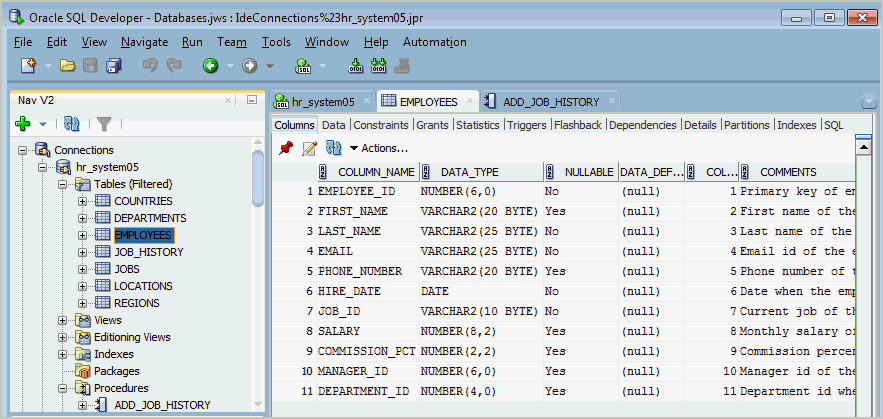
The following combinations of Access Bridge file versions are necessary to achieve optimal functionality with JAWS 3.70, since this version of the screen reader uses older Java technology than is used in SQL Developer. There are two stacks of software technology listed below for those who want to use either version 1.0.3 or 1.0.4 of the Access Bridge. Also required in the system32 directory is a copy of the latest version of the Access Bridge jar file.
Access Bridge v. 1.0.3 Configuration for SQL Developer
Place the following files in the <sqldeveloper_install>jdkjrelibext directory:
Place the following file in the <sqldeveloper_install>jdkjrelib directory:
Place the following files in the Windows system32 directory:
Access Bridge v. 1.0.4 Configuration for SQL Developer
Place the following files in the <sqldeveloper_install>jdkjrelibext directory:
Place the following file in the <sqldeveloper_install>jdkjrelib directory:
Place the following files in the Windows system32 directory:
1.10 Uninstalling SQL Developer
Before you uninstall SQL Developer, if you plan to install SQL Developer (the same or an updated version) later, you may want to save your existing database connections; and if so, see Section 1.4 before uninstalling.
To uninstall SQL Developer, remove the entire SQL Developer installation directory (that is, the directory named sqldeveloper and all directories and files under it in the hierarchy).
If you also want to remove all user-specific SQL Developer information, you should also delete the directory under which that information is stored (that is, the SQL Developer user information directory). For the location of this directory, see Section 1.5.
If you have created a shortcut for SQL Developer, and if you do not plan to install SQL Developer into the same location again, you should remove that shortcut or modify the shortcut properties to reflect the new location.
1.11 SQL Developer Documentation
SQL Developer provides user documentation in the Oracle Database SQL Developer User's Guide and in the online help. To see the help, click the Help menu, or click the Help button or press the F1 key in relevant contexts while you are using SQL Developer.
In addition to the user's guide and installation guide, the following migration-related guides are available:
Oracle Database SQL Developer Supplementary Information for Microsoft Access Migrations
Oracle Database SQL Developer Supplementary Information for MySQL Migrations
Oracle Database SQL Developer Supplementary Information for Microsoft SQL Server and Sybase Adaptive Server Migrations
1.12 Oracle on the Web
Oracle provides a number of resources on the Web. These are some sites you may find helpful:
Oracle Sql Developer Data Modeler For Mac Download
SQL Developer home page (OTN):
http://www.oracle.com/technology/products/database/sql_developer/SQL Developer discussion forum (OTN):
http://forums.oracle.com/forums/forum.jspa?forumID=260Oracle Technology Network (OTN):
http://www.oracle.com/technology/PL/SQL page on OTN:
http://www.oracle.com/technology/tech/pl_sql/Oracle Accessibility site:
http://www.oracle.com/accessibility/Oracle Corporate site:
http://www.oracle.com/
